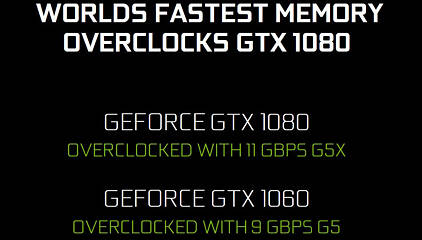 48
48
MSI GTX 1080 Gaming X Plus 11 Gbps 8 GB Review
Packaging & Contents »Introduction

NVIDIA's $650 GeForce GTX 1080 Ti launch announcement brought cheer to two other market segments. With the GTX 1080 Ti, NVIDIA innovated improvements to its memory controller that let it address memory at higher clocks. It armed the GTX 1080 Ti with 11 Gbps GDDR5X memory, which let it more than make up for the slightly narrower memory bus in comparison to the TITAN X Pascal. It simultaneously announced product updates to the $500 GeForce GTX 1080 and $230 GeForce GTX 1060 6 GB, with the GTX 1080 receiving this faster 11 Gbps GDDR5X memory and the GTX 1060 6 GB receiving 9 GHz GDDR5 memory.
The idea here is to give the GTX 1080 and GTX 1060 6 GB the kind of performance-boosting updates NVIDIA usually reserves for product rebrands since the two are less than a year old, and the company hopes to prevent the GTX 1080 from withering away in the wake of the GTX 1080 Ti launch, much in the same way its predecessor, the GTX 980, lost market to the GTX 980 Ti launch. There's also a huge 35% performance gap between the original GTX 1080 and GTX 1080 Ti, which NVIDIA may want to narrow, probably to preempt the AMD Radeon Vega.
The new-gen GTX 1080 is every bit identical to the original. The magic happens with the new 11 Gbps-rated memory chips and an updated video BIOS, which tells the GP104's memory controllers how to work reliably at 11 Gbps. These SKU updates have prompted a slew of new product launches from NVIDIA add-in board partners. The refreshed GTX 1080 and GTX 1060 6 GB are clearly distinguished from the originals by memory speed markings in the SKU label (that green square in the bottom-right corner of the graphics card box).

In this review, we're taking a look at the new MSI GeForce GTX 1080 Gaming X Plus, armed with 11 Gbps GDDR5X memory. MSI introduced the "Gaming X Plus" brand extension with updated GTX 1080 and GTX 1060 6 GB graphics cards, besides its Radeon RX 580 lineup. It is positioned between the Gaming X and top-tier Gaming Z extension. The card features slightly higher GPU clocks than the original GTX 1080 Gaming X, besides the faster memory. It also features the same TwinFrozr VI cooling solution, mated with a custom-design PCB.
| GeForce GTX 980 Ti | Radeon R9 Fury X | GeForce GTX 1070 | GeForce GTX 1080 | MSI GeForce GTX 1080 Gaming X+ | GeForce GTX 1080 Ti | GeForce Titan X Pascal | |
|---|---|---|---|---|---|---|---|
| Shader Units | 2816 | 4096 | 1920 | 2560 | 2560 | 3584 | 3584 |
| ROPs | 96 | 64 | 64 | 64 | 64 | 88 | 96 |
| Graphics Processor | GM200 | Fiji | GP104 | GP104 | GP104 | GP102 | GP102 |
| Transistors | 8000M | 8900M | 7200M | 7200M | 7200M | 12000M | 12000M |
| Memory Size | 6 GB | 4 GB | 8 GB | 8 GB | 8 GB | 11 GB | 12 GB |
| Memory Type | GDDR5 | HBM | GDDR5 | GDDR5X | GDDR5X | GDDR5X | GDDR5X |
| Memory Bus Width | 384 bit | 4096 bit | 256 bit | 256 bit | 256 bit | 352 bit | 384 bit |
| Core Clock | 1000 MHz+ | 1050 MHz | 1506 MHz+ | 1607 MHz+ | 1683 MHz+ | 1481 MHz+ | 1418 MHz+ |
| Memory Clock | 1750 MHz | 500 MHz | 2002 MHz | 1251 MHz | 1376 MHz | 1376 MHz | 1251 MHz |
| Price | $390 | $380 | $350 | $500 | $570 | $700 | $1200 |
May 5th, 2025 23:18 EDT
change timezone
Latest GPU Drivers
New Forum Posts
- What's your latest tech purchase? (23718)
- Graphics card holders are a disaster waiting to happen (15)
- 7900XT - Lower my GPU too constatly be running 500-600rpm (33)
- Pc crash (2)
- Rare GPUs / Unreleased GPUs (2072)
- Steam installer asked me if I got Dial Up! (9)
- What are you playing? (23554)
- [AV1, AV2, AV3 codecs...] Have they given up on the AOMedia project? (24)
- Hundreds of WHEA-17 Hardware Errors per minute? (3)
- is it possible to buy a sata to propietary dell pata adapter? (11)
Popular Reviews
- Arctic Liquid Freezer III Pro 360 A-RGB Review
- ASUS Radeon RX 9070 XT TUF OC Review
- Clair Obscur: Expedition 33 Performance Benchmark Review - 33 GPUs Tested
- ASUS ROG Maximus Z890 Hero Review
- Zotac GeForce RTX 5070 Ti Amp Extreme Review
- Upcoming Hardware Launches 2025 (Updated Apr 2025)
- Seasonic Vertex GX 850 W Review
- Sapphire Radeon RX 9070 XT Nitro+ Review - Beating NVIDIA
- ASUS GeForce RTX 5090 Astral Liquid OC Review - The Most Expensive GPU I've Ever Tested
- Montech HS02 PRO Review
Controversial News Posts
- AMD Radeon RX 9060 XT to Roll Out 8 GB GDDR6 Edition, Despite Rumors (131)
- NVIDIA Sends MSRP Numbers to Partners: GeForce RTX 5060 Ti 8 GB at $379, RTX 5060 Ti 16 GB at $429 (128)
- NVIDIA Launches GeForce RTX 5060 Series, Beginning with RTX 5060 Ti This Week (115)
- Nintendo Confirms That Switch 2 Joy-Cons Will Not Utilize Hall Effect Stick Technology (105)
- NVIDIA PhysX and Flow Made Fully Open-Source (95)
- Sony Increases the PS5 Pricing in EMEA and ANZ by Around 25 Percent (84)
- Parts of NVIDIA GeForce RTX 50 Series GPU PCB Reach Over 100°C: Report (78)
- Intel "Bartlett Lake-S" Gaming CPU is Possible, More Hints Appear for a 12 P-Core SKU (77)

